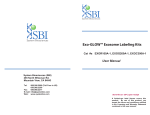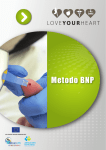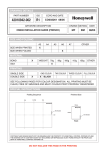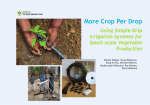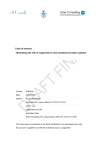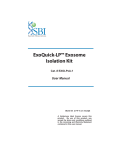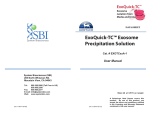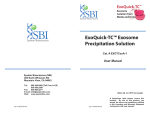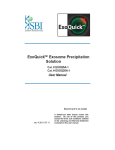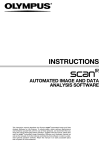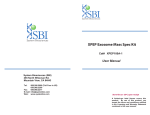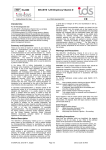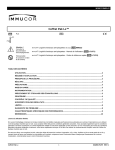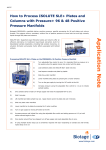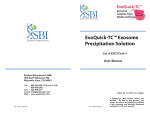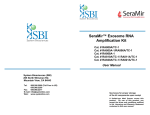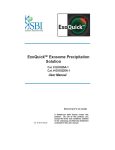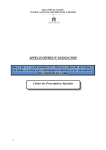Download Exo-Flow and IP Kits User Manual
Transcript
Cat #s . EXOFLOWxxx User Manual Store Kits at +4ºC upon receipt A limited-use label license covers this product. By use of this product, you accept the terms and conditions outlined in the Licensing and Warranty Statement contained in this user manual. Exo-Flow™ Exosome Capture Kits Cat. # EXOFLOWxxx Contents I. Introduction ..............................................................................1 A. Exosome Overview .................................................................1 B. Magnetic Beads and Exosome Surface Markers ...................2 C. The Exo-FITC™ Universal and Reversible Stain ...................4 D. Exo-Flow FACS Protocols ......................................................4 E. Sample Exo-Flow FACS data .................................................7 F. Exo-FITC stain removal and exosome elution ......................10 G. List of Components for Flow FACS kits................................11 H. Additional Materials Required ...............................................11 I. Exo-Flow96 and 32 Exosome IP Kits ....................................11 J. Related Products ...................................................................14 K. Shipping and Storage Conditions for Kit ...............................14 II. Frequently Asked Questions .................................................14 III. References .........................................................................14 IV. Technical Support ..............................................................16 VII. Licensing and Warranty information ..................................16 I. Introduction A. Exosome Overview Exosomes are 60 - 180 nm membrane vesicles secreted by most cell types in vivo and in vitro. These microvesicles are produced by the inward budding of multivesicular bodies (MVBs) and are released from the cell into the microenvironment following the fusion of MVBs with the plasma membrane. Exosomes are extracellular, nanoshuttle organelles that facilitate communication between cells and organs. Exosomes are found in blood, urine, amniotic fluid, breast milk, malignant ascites fluids and contain distinct subsets of RNAs and proteins depending upon the cell type from which they are secreted, making them useful for biomarker discovery. SBI has engineered tools and nextgeneration sequencing services to accelerate the study of exosomes, exosome protein and RNA biomarkers. The Exo-Flow kits have two major applications: 1) Purify exosome with specific surface markers for FACS analytics and purification and 2) high-throughput immunopurification (IP) of exosomes from media, serum and other biofluids in 96 well formats. The Exo-Flow kits for FACS These kits are for the selective capture and flow sorting to purify distinct subpopulations of exosomes, based on a particular surface marker. You will first enrich for all exosomes using ExoQuick (serum, plasma, ascites samples) or ExoQuick-TC (cell media, urine, spinal fluid). The isolated exosomes are then resuspended and bound to the magnetic beads for specific capture and subsequent FACS analysis and sorting. The Exo-Flow kits are modular, thus you can select from various pre-validated capture antibody kits, or utilize your own biotinylated capture antibody 888-266-5066 (Toll Free) 650-968-2200 (outside US) Page 1 System Biosciences (SBI) User Manual corresponding to the exosome surface marker specific for the exosomes of interest in your model system. SBI has thoroughly tested a variety of capture antibodies that work quite well to flow-sort exosomes from either serum or cell culture samples. Flow “Exometry” SBI has developed a simple, one-step method for precipitation of all exosomes from biofluids using polymer formulations. The ExoQuick™ reagent can be used to isolate exosomes from serum, plasma and tumor ascites fluids. Exosomes from more dilute, larger volume fluids like cell culture media, using, cerebral spinal fluid can be efficiently isolated using SBI’ ExoQuick-TC™. While ExoQuick isolation of exosomes is rapid and easy, this method will isolate every exosome from your biofluid sample. The Exo-Flow™ kits are designed to enable the selective capture and flow sorting to purify distinct subpopulations of exosomes, based on a particular surface marker. You will first enrich for all exosomes using ExoQuick (serum, plasma, ascites samples) or ExoQuick-TC (cell media, urine, spinal fluid). The isolated exosomes are then resuspended and bound to the magnetic beads for specific capture and subsequent flow exometry. The Exo-Flow kits for High-throughput IP The Exo-Flow96 and 32 IP kits enable the high-throughput, plate-based immunopurification of exosomes directly from serum or from concentrated exosomes from media (with ExoQuick-TC or ultracentrifugation). The magnetic beads are provided pre-coupled with either CD9, CD63 or CD81 for selective capture of distinct subsets of exosomes from either 96 or 32 samples simultaneously. Why is this important? Exosomes found in biofluids can originate from any tissue or cell type and end up in the serum fraction. If you are interested in just the immune-related exosomes, you would need to capture them using a specific exosome surface marker like HLA-G, same goes for tumor-derived exosome populations. The most efficient method for exosome subpopulation purification is using the Exo-Flow kits. B. Magnetic Beads and Exosome Surface Markers SBI has developed a magnetic streptavidin 9.1 µm Exo-Flow bead system with ultra-high exosome binding capacity. The 9.1 µm diameter of the beads enables more exosome capture per volume added when compared to 4 µm Dynabeads. This is significant in that some exosome subpopulations that are desired may only be present in very low numbers. The increased surface area enables the more efficient capture of these rare exosomes. Bigger is better. Fig. 1: Exo-Flow streptavidin magnetic beads Depending upon the specific exosomes you wish to purify, a particular biotinylated antibody may be used to couple to the Exo-Flow streptavidin beads. The Exo-Flow kits are modular, thus you can select from various pre-validated capture antibody kits, or utilize your own biotinylated capture antibody corresponding to the exosome surface marker specific for the exosomes of interest in your model system. SBI has thoroughly tested a variety of capture antibodies that work quite well to flow-sort exosomes from either serum or cell culture samples. These are highlighted by arrows in the diagram below. Page 2 ver. 7-01142014 www.systembio.com Exo-Flow™ Exosome Capture Kits Cat. # EXOFLOWxxx There are a few categories of known exosome surface markers based upon some functional attributes: Fig. 2: Exosome surface marker examples The Exo-Flow beads will appear as an orange or “pumpkin” like color which allows for them to be easily tracked during the magnetic separations and washes. The beads adhere strongly after placed on the magnetic stand such that clean separations and washes can be achieved. The Exo-Flow kit system also offers a multifunctional magnetic stand as an accessory option (catalog# EXOFLOW700A-1). These have been validated to work very well with the Exo-Flow beads and can accommodate 12 standard 1.5 mL eppendorf tubes or the stand can be flipped and then used for two standard 15 mL or 50 mL conical tube exosome separations. 888-266-5066 (Toll Free) 650-968-2200 (outside US) Page 3 System Biosciences (SBI) User Manual C. The Exo-FITC™ Universal and Reversible Stain Once the desired exosomes have been captured and stabilized on the Exo-Flow beads, you will need to “stain” these exosomes with a fluorescent moiety to perform the FACS. One method is to use a second antibody conjugated to PE, APC, ALEXAs or FITC to accomplish this goal. These typically offer low staining ability and can be costly for multiple exosome sample purifications. SBI has invented a novel method to universally stain captured exosomes on the beads. The technology takes advantage of the findings that most exosome surface proteins have modifications (ex. glycosylations, carbohydrate additions, etc.). The Exo-FITC stain supplied in all kits features FITC fluorescent molecules conjugated to a protein known to universally bind these types of protein modifications. This allows for a more general and inexpensive exosome FACS approach for captured exosome purification. The other key feature is that the ExoFITC stain is also reversible. Once the captured exosomes on the ExoFlow beads are flow-sorted on FITC-positive gating, the Exo-FITC stain can then be washed away and exosomes eluted off of the beads with the Exosome Elution Buffer wash buffer (supplied in all kits). Add the Exosome Elution Buffer to the exosome-bead mixture to simultaneously remove the Exo-FITC stain and liberate the intact exosomes from the beads. Then simply place the magnetic beads back on the magnetic stand, the eluted and FACSpurified exosomes will be in the supernatant. The exosome are intact and ready for downstream analysis and functional studies. IMPORTANT NOTE: If you want to double-stain your captured exosomes with a conjugated secondary antibody and the Exo-FITC stain, you MUST FIRST stain the exosomes on the beads with your conjugated secondary antibody, wash, then stain with the Exo-FITC stain. D. Exo-Flow FACS Protocols To ensure the best success of your flow exometry experiments, please follow the protocols exactly as stated below. DO NOT vortex the beads when exosomes are bound, this will shear them and break them apart leading to no flowsorting positive results. Most steps can be performed at ambient (room) temperature unless otherwise indicated. We highly recommend using concentrated exosomes using SBI’s ExoQuick or ExoQuick-TC. Exosomes isolated through centrifugation for concentration may be used as well. Materials (10 reaction kits) • Streptavidin Magnetic Beads 9.1 µm, 400 L at 10 mg/mL, 1.6x10^7 beads/mL, 1.6x10^6 beads/mg. We will use 0.4 mg per reaction, 6.4x10^6 beads per tube. Beads will have an orange “pumpkin” coloring making them Pa g e 4 ver. 7-01142014 www.systembio.com Exo-Flow™ Exosome Capture Kits Cat. # EXOFLOWxxx easy to track during the washings. • Biotinylated capture antibody, 100 ng/L in PBS, 100 L provided (examples, CD9, Rab5b, HLA-G, depending upon specific kit). • Magnetic stand (optional, cat# EXOFLOW700A-1). • Bead Wash buffer, 60 mL. • Exosome Stain Buffer, 3 mL. • Exo-FITC Universal exosome stain, 100 l provided. • Exosome Elution Buffer, 3 mL provided. ExoQuick and ExoQuick-TC are not provided in the Exo-Flow kits and can be purchased separately. The following ExoQuick products are recommended for exosome concentration prior to Exo-Flow purification. Description Size Catalog # ExoQuick Serum exosome precipitation solution (5 ml) 75 reactions EXOQ5A-1 ExoQuick Plasma prep and Exosome precipitation kit (5 ml ExoQuick plus Thrombin) 75 reactions EXOQ5TM-1 Thrombin Plasma prep for Exosome precipitation 100 reactions TMEXO-1 ExoQuick Serum exosome precipitation solution (20 ml) 300 reactions EXOQ20A-1 ExoQuick-TC for Tissue Culture Media and Urine (10 ml) 10 reactions EXOTC10A-1 ExoQuick-TC for Tissue Culture Media and Urine (50 ml) 50 reactions EXOTC50A-1 Exosome isolation protocol Combine your biofluid sample containing exosomes with ExoQuick or ExoQuick-TC using the guidelines shown in the Table below. Mix the ExoQuick precipitation reagent with the biofluid sample by inversion and place at 4°C for 30 minutes to overnight, then recover the exosomes in a pellet with a low speed spin. Please refer to the ExoQuick or ExoQuick-TC User manuals for more details. Recommended amounts of exosomes provided in Table. Biofluid Sample volume ExoQuickTC volume Resuspend exosome pellet Volume to use in Exo-Flow Urine 10 ml 2 ml 500 L PBS 100 L/rxn Spinal fluid 10 ml 2 ml 500 L PBS 100 L/rxn Culture media 10 ml 2 ml 500 L PBS 100 L/rxn 888-266-5066 (Toll Free) 650-968-2200 (outside US) Page 5 System Biosciences (SBI) User Manual Biofluid Sample volume ExoQuick Serum 250 L 63 L Plasma 250 L 63 L Ascites fluid 500 L 120 L Resuspend exosome pellet 500 L PBS 500 L PBS 250 L PBS Volume to use in ExoFlow 100 L/rxn 100 L/rxn 100 L/rxn Amount of exosomes to use The number of exosomes in a given biofluid will vary depending upon the sample itself. There are abundant levels of exosome in serum, less in cell culture medium and urine. Use the guidelines in the Tables above as a starting point. You can typically add about 100-200 g protein of isolated, intact exosomes per Exo-Flow reaction. Exo-Flow FACS Magnetic bead preparation 1. Vortex bead slurry briefly and then pipette 40 L of bead slurry solution into a 1.5 mL tube per sample. 2. Place samples on magnetic stand for 2 minutes. 3. Carefully remove the supernatant after 2 minutes. Make sure to not disturb the magnetic bead pellets. 4. Remove samples from magnetic stand and add 500 L of Bead Wash buffer. Invert a few times. 5. Place samples on magnetic stand and repeat steps 2-4 for a total of 2 washes. 6. Remove all liquid so only beads are on the side of the tube. Binding of capture antibody to beads 7. Remove tubes from magnetic stand and add 10 L of biotinylated capture antibody (ie. CD9, CD63) per sample, using the pipette tip to move the beads to the bottom of the tube, mix by pipetting up and down three times.. 8. Place tubes on ice for 2 hours. Flick the tube every 30 minutes to gently mix. 9. Add 200 L Bead Wash buffer and flick to mix. 10. Place samples on magnetic stand for 2 minutes. 11. Carefully remove the supernatant after 2 minutes. Make sure to not disturb the magnetic bead pellets. 12. Remove samples from magnetic stand and add 500 L Bead Wash buffer. Invert a few times; DO NOT VORTEX. Flick tubes to mix. 13. Place samples on magnetic stand and repeat steps 10-12 for a total of 3 washes. 14. Suspend capture antibody-beads with 400 L Bead Wash buffer per sample. Exosome capture 15. Add 100 L of concentrated, isolated exosomes to each bead sample for a total volume of 500 L. 16. Incubate on a rotating rack at 4°C overnight for capture. Page 6 ver. 7-01142014 www.systembio.com Exo-Flow™ Exosome Capture Kits Cat. # EXOFLOWxxx 17. Place samples on magnetic stand for 2 minutes. 18. Carefully remove the supernatant after 2 minutes. Make sure to not disturb the magnetic bead pellets. 19. Remove samples from magnetic stand and add 500 µL Bead Wash buffer. Invert a 2-3 times; DO NOT VORTEX. Flick tubes to mix. 20. Place samples on magnetic stand and repeat steps 3-5 for a total of 2 washes. Exosome staining 21. Add 240 µL of Exosome Stain Buffer and 10 µL of Exo-FITC exosome stain for a final volume of 250 µL per sample. 22. Place tubes on ice for 2 hours. Flick the tube every 30 minutes to gently mix. 23. Place samples on magnetic stand for 2 minutes. 24. Carefully remove the supernatant after 2 minutes. Make sure to not disturb the magnetic bead pellets. 25. Remove samples from magnetic stand and add 500 µL Bead Wash buffer. Invert a few times; DO NOT VORTEX. Flick tubes to mix. 26. Place samples on magnetic stand and repeat steps 23-25 for a total of 3 washes. 27. Resuspend samples in 300 µL Bead Wash buffer for flow cytometry. 28. DO NOT VORTEX prior to loading into FACS instrument. Exosome Stain removal and elution (if desired) 29. Flow-sort stained exosome/bead complexes as desired. 30. Place the stained exosome/bead complexes on the magnetic stand for 2 minutes. 31. Remove buffer and add 300 µl Exosome Elution Buffer, Invert a few times; DO NOT VORTEX. Flick tubes to mix. 32. Incubate on a rotating rack or shaker at 25°C for 2 hours. 33. Place samples on magnetic stand for 2 minutes. 34. Carefully remove the supernatant containing your eluted exosomes and transfer to a fresh tube. Make sure to not disturb the magnetic bead pellets. Discard beads after use. E. Sample Exo-Flow FACS data erase The data below were generated on a BD LSR II instrument and are meant as examples of how to set the gate settings and perform data analysis using FlowJo software. Information on FlowJo software can be viewed online. http://www.flowjo.com/ Exo-Flow software gate settings The forward and side scatter data for the 9.1 um Exo-Flow beads are shown below for samples containing no captured exosomes stained with Exo-FITC (left panel) and then data for serum CD9-captured exosomes stained with 888-266-5066 (Toll Free) 650-968-2200 (outside US) Page 7 System Biosciences (SBI) User Manual Exo-FITC. Set the gate primarily on the majority bead singlets (outlined in a black oval, red arrow pointing to the gate setting) prior to full flow analysis. Exo-Flow exosome flow-exometry example data Bead flow separation data for the various capture antibodies coupled with Exo-FITC staining are shown below. The data are graphed showing forward scatter versus FITC intensity. The first panel depicts beads with no exosomes then with exosomes. The degree of flow separation is shown on the right side for each capture set. Page 8 ver. 7-01142014 www.systembio.com Exo-Flow™ Exosome Capture Kits Cat. # EXOFLOWxxx Exo-Flow FACS exosome binding capacity data Human serum exosomes were isolated from 250 l serum using ExoQuick. The exosome pellet was resuspended in 500 l 1x PBS. The amount of exosome particles were added in two-fold dilutions starting at 50 l and then captured using the biotinylated CD9 antibody and Exo-Flow beads. The FITC flow cytometric intensities are then plotted versus the number of exosome particles input into the flow reaction. The Exo-Flow system has the capacity to capture, flow and detect BILLIONS of exosomes. 888-266-5066 (Toll Free) 650-968-2200 (outside US) Page 9 System Biosciences (SBI) User Manual F. Exo-FITC stain removal and exosome elution Once you have flow-sorted the captured exosomes of interest, the Exo-FITC stain can be easily removed and intact exosomes eluted safely. This can enable you to then perform downstream analysis and functional studies. The data below show the efficient Exo-FITC stain removal and exosome elution. The flow-sort results from CD9 captured exosomes, stained with Exo-FITC, and then eluted with the Exosome Elution Buffer. The entire bead population returns to pre-stain FITC intensities and NanoSight studies verify the recovery of intact exosomes. Page 10 ver. 7-01142014 www.systembio.com Exo-Flow™ Exosome Capture Kits Cat. # EXOFLOWxxx G. List of Components for Flow FACS kits The Exo-Flow kits contain enough reagents to perform up to 10 FACS flow-exometry experiments. Item Streptavidin Magnetic Beads, 9.1 µm Biotinylated capture antibody, 100 ng/L in PBS (multiple varieties) Bead Wash buffer Amount 200 L at 10 mg/mL 100 L Exosome Stain Buffer 60 mL 3 mL Exo-FITC Universal exosome stain 100 L Exosome Elution Buffer 3 mL Magnetic stand (optional, cat# EXOFLOW700A-1) 1 Stand H. Additional Materials Required 1) ExoQuick and/or ExoQuick-TC to concentrate exosome prior to antibody-bead capture. 2) Magnetic stand, or purchase SBI’s Multifunctional stand (cat# EXOFLOW700A-1) 3) FACS instrument for flow cytometry 4) Sterile, 1.5 mL sample tubes I. Exo-Flow96 and 32 Exosome IP Kits The Exo-Flow96 and 32 IP kits enable the high-throughput, plate-based immunopurification of exosomes directly from serum or from concentrated exosomes from media (concentrated with ExoQuick-TC or ultracentrifugation). The magnetic beads are provided pre-coupled with either CD9, CD63 or CD81 antibodies for selective capture of exosomes from either 96 or 32 samples simultaneously. The Exo-Flow96 kits contain all of the reagents for exosome IP purifications from 96 samples and the Exo-Flow32 kit has all of the reagents for 32 samples. Exosomes in serum or plasma samples can be immunopurified directly by adding to the IP magnetic beads. We recommend concentrating exosomes first from media, urine and CSF before immunopurifcation. Choose from exosome IP antibodies for CD9, CD63 or CD81 surface markers. The exosome are immunopurified and eluted intact - allowing for downstream functional studies as well as for exoRNA and protein biomarker analyses. Materials provided: 96 well clear plate (8 well strips) and covers Capture Antibody pre-coupled with magnetic beads Wash buffer (20X stock) Exosome Elution Buffer Clearing reagent (to dissolve elution reagent away from exosomes) Exo-FlowMag96 magnetic 96- well rack (sold separately) 888-266-5066 (Toll Free) 650-968-2200 (outside US) Page 11 System Biosciences (SBI) User Manual Protocol for ExoFlow96 or 32: Cat# EXOFLOWMAG-1 1. Add 20 µl of antibody coupled with magnetic beads to each well of the plate provided per capture reaction. 2. Add 50 µL of concentrated, isolated exosomes from media samples (isolated by ExoQuick-TC or ultracentrifugation) or directly load serum samples to each bead well for a total volume of 70 µl into the 96 well plate provided. 3. Incubate on a shaker at room temperature overnight for exosome capture. 4. Place samples on the Exo-FlowMag96 magnetic 96 well rack for 2 minutes. You should hear a subtle “click” when the plate is properly aligned with the magnetic plate. 5. Keep the clear plate on the magnetic rack and then decant the supernatant. Make sure to not disturb the magnetic bead pellets at the bottom of the wells. 6. Remove the 96 well plate from the magnetic rack and gently add 50 µl of 1X Wash buffer (made fresh from the 20X stock provided). 7. Mix by pipetting up and down 3 times and incubate on a shaker at room temperature for 5 minutes. 8. Repeat steps 4-6 for a total of 2 washes. 9. Remove any residual Wash buffer after decanting and then add 100 l Exosome Elution Buffer to each well of the 96 well plate. 10. Incubate on a shaker at room temperature for 1 hour. 11. Place samples plate on the magnetic rack for 2 minutes. 12. Carefully remove the supernatant containing eluted, intact exosomes and transfer to a fresh tube on ice. Make sure not to disturb the magnetic bead pellets. Discard the beads afterwards. The immunopurified exosomes are stable at +4°C for several days or can be frozen at -80°C for long term storage. Example data of exosome recoveries for intact exosomes and the number of exosome particles can be seen in the Figure below. Page 12 ver. 7-01142014 www.systembio.com Exo-Flow™ Exosome Capture Kits Cat. # EXOFLOWxxx Exosome concentrations recovered using the Exo-Flow IP kits were measured by NanoSight analysis (below). The data below demonstrate the exosome recoveries, with sizes centered around 88 nm in diameter. The HEK 293 media exosomes were purified from 20 ml media and concentrated using ExoQuick-TC and resuspended in 1 mL PBS. Then 50 µl of the concentrated media exosomes were added per well for the immunopurifications. The serum exosomes were isolated from 50 µl of human serum added directly to the bead capture mixture. Optional: Western blotting Protocol a. To the eluted exosome supernatant containing, add 1 ul of the clearing reagent, this dissolves the elution buffer away from the exosomes. b. Invert it a few times to mix it well. c. Incubate at 37 °C for 30 minutes(the sample is now ready for Westerns). d. Measure the protein concentration of the samples. Load 1-5 ug protein sample per well. e. Add 10 ul of 5x loading dye to the sample in a total of 50 ul and boil for 5 minutes at 95°C. f. Perform standard SDS-PAGE electrophoresis and Western transfer onto nitrocellulose membranes. g. Block with 5% dry milk in Tris Buffered Saline +0.05 % Tween (TBST) for 1 hour or Blocking buffer for 1 hour. h. Incubate blot overnight at 4°C with exosome-specific primary antibody (eg. Anti-CD63) at 1: 1,000 dilution (5% dry milk in TBS-T). i. Drain the antibody solution. j. Wash with TBS-T for 3X 5 minutes. k. Drain the wash solution. l. Prepare exosome validated secondary antibody at 1: 20,000 dilution (5% dry milk in TBS-T). m. Incubate one hour at room temperature with exosome validated secondary antibody at 1:20,000 dilution (5% dry milk in TBS-T). n. Wash with TBS-T for 3X 5 minutes. o. Drain the wash solution. p. Prepare detection solution. 888-266-5066 (Toll Free) 650-968-2200 (outside US) Page 13 System Biosciences (SBI) q. r. s. t. u. User Manual Add 5 ml developing solution to the membrane. Incubate at room temperature for 2 minutes. Take the membrane out of the dish, drain excess detecting solution using kimwipe. Place the membrane on a plastic surface for imaging. Detect signals with chemi-luminescence and expose the membrane for 5-45 seconds to image signals. J. Related Products SBI offers a number of exosome research products. Review them here: http://www.systembio.com/exosomes • • • • • ExoQuick exosome isolation reagents Exo-FBS exosome-depleted media supplement Detect and quantitate exosomes with Antibodies and ELISAs Purify exosome RNA and profile by qPCR with SeraMir Discover novel exoRNA biomarkers with Next-Gen sequencing services K. Shipping and Storage Conditions for Kit The Exo-Flow kits are shipped on blue ice and should be stored at +4°C. Avoid freeze-thawing the reagents. Shelf life of the product is 1 year after receipt if stored in +4°C. II. Frequently Asked Questions Q. How many exosomes should I start with before flow-sorting? The biofluid type and cell culture media source will determine just how many exosomes are present. The best way is to first isolate and concentrate the exosomes of interest. Resuspend the isolated exosomes in a minimal volume (10% of starting volume) with 1X PBS. Take a protein concentration measurement and use approximately 50 g to 200 g exosome protein input per Exo-Flow capture experiment. Q. If I want to detect the captured exosomes using a fluorescently-conjugated secondary antibody, how much should I use? Every antibody is different and will have varying degrees of affinity. This is best determined experimentally for each antibody tried. We recommend starting with at least 50 g secondary antibody. The Exo-FITC stain can serve as a positive control for the presence of exosomes during your FACS analysis. Q. What are the species cross-reactivities of each of the Exo-Flow antibodies? All of the Exo-Flow capture antibodies have been optimized for human exosome capture. Due to the high protein sequence conservation of many of these exosome surface markers, cross-species reactivity is likely, but SBI has not tested all mammalian species yet. The Rab5b biotinylated antibody has the most cross-species capture reactivity (Human, Mouse, Rat, Chicken, Pig, Cow, Horse, Rabbit, Sheep) and can be used to develop your exosome flowsorting experiments. III. References Huang X, Yuan T, Tschannen M, Sun Z, Jacob H, Du M, Liang M, Dittmar RL, Liu Y, Liang M, Kohli M, Thibodeau SN, Boardman L, Wang L. Characterization of human plasma-derived exosomal RNAs by deep sequencing. BMC Genomics. 2013 May 10;14:319. Kurbegovic A, Trudel M. Progressive development of polycystic kidney disease in the mouse model expressing Pkd1 extracellular domain. Hum Mol Genet. 2013 Jun 15;22(12):2361-2375. Page 14 ver. 7-01142014 www.systembio.com Exo-Flow™ Exosome Capture Kits Cat. # EXOFLOWxxx Bhattarai N, McLinden JH, Xiang J, Landay AL, Chivero ET, Stapleton JT. GB Virus C Particles Inhibit T Cell Activation via Envelope E2 Protein-Mediated Inhibition of TCR Signaling. J Immunol. 2013 May 17. [Epub ahead of print]. Narayanan A, Iordanskiy S, Das R, Van Duyne R, Santos S, Jaworski E, Guendel I, Sampey G, Gerhart E, IglesiasUssel M, Popratiloff A, Hakami R, Kehn-Hall K, Young M, Subra C, Gilbert C, Bailey C, Romerio F, Kashanchi F. Exosomes derived from HIV-1 infected cells contain TAR RNA. J Biol Chem. 2013 May 9. [Epub ahead of print]. Carlos Salomon, Luis Sobrevia, Keith Ashman, Sebastian E. Illanes, Murray D. Mitchell and Gregory E. Rice. The Role of Placental Exosomes in Gestational Diabetes Mellitus, Gestational Diabetes-Causes, Diagnosis and Treatment. Dr. Luis Sobrevia (Ed.), ISBN: 978-953-51-1077-4, InTech, DOI: 10.5772/55298. Skrzypek K, Tertil M, Golda S, Ciesla M, Weglarczyk K, Collet G, Guichard A, Kozakowska M, Boczkowski J, Was H, Gil T, Kuzdzal J, Muchova L, Vitek L, Loboda A, Jozkowicz A, Kieda C, Dulak J. Interplay between heme oxygenase1 and miR-378 affects non-small cell lung carcinoma growth, vascularization and metastasis. Antioxid Redox Signal. 2013 Apr 25. [Epub ahead of print]. Haney MJ, Zhao Y, Harrison EB, Mahajan V, Ahmed S, et al. Specific Transfection of Inflamed Brain by Macrophages: A New Therapeutic Strategy for Neurodegenerative Diseases. PLoS ONE 8(4): e61852. doi:10.1371/journal.pone.0061852. Hu G, Gong AY, Roth AL, Huang BQ, Ward HD, Zhu G, Larusso NF, Hanson ND, Chen XM. Release of Luminal Exosomes Contributes to TLR4-Mediated Epithelial Antimicrobial Defense. PLoS Pathog. 2013 Apr;9(4):e1003261. Danny A. Kanhai, Frank L.J. Visseren, Yolanda van der Graaf, Arjan H. Schoneveld, Louise M. Catanzariti, Leo Timmers, L. Jaap Kappelle, Cuno S.P.M. Uiterwaal, Sai Kiang Lim, Siu Kwan Sze, Gerard Pasterkamp, Dominique P.V. de Kleijn, on behalf of the SMART Study Group. Microvesicle protein levels are associated with increased risk for future vascular events and mortality in patients with clinically manifest vascular disease. International Journal of Cardiology, ISSN 0167-5273, 10.1016/j.ijcard.2013.01.231. (PDF) » Katakowski M, Buller B, Zheng X, Lu Y, Rogers T, Osobamiro O, Shu W, Jiang F, Chopp M. Exosomes from marrow stromal cells expressing miR-146b inhibit glioma growth. Cancer Lett. 2013 Feb 15. pii: S0304-3835(13)00131-6. doi: 10.1016/j.canlet.2013.02.019. Choi DS, Kim DK, Kim YK, Gho YS. Proteomics, transcriptomics, and lipidomics of exosomes and ectosomes. Proteomics. 2013 Feb 11. doi: 10.1002/pmic.201200329. [Epub ahead of print]. Munch EM, Harris RA, Mohammad M, Benham AL, Pejerrey SM, Showalter L, Hu M, Shope CD, Maningat PD, Gunaratne PH, Haymond M, Aagaard K. Transcriptome Profiling of microRNA by Next-Gen Deep Sequencing Reveals Known and Novel miRNA Species in the Lipid Fraction of Human Breast Milk. PLoS One. 2013;8(2):e50564. 888-266-5066 (Toll Free) 650-968-2200 (outside US) Page 15 System Biosciences (SBI) IV. User Manual Technical Support For more information about SBI products and to download manuals in PDF format, please visit our web site: http://www.systembio.com For additional information or technical assistance, please call or email us at: System Biosciences (SBI) 265 North Whisman Rd. Mountain View, CA 94043 Phone: (650) 968-2200 (888) 266-5066 (Toll Free) Fax: (650) 968-2277 E-mails: General Information: [email protected] Technical Support: [email protected] Ordering Information: [email protected] VII. Licensing and Warranty information Limited Use License Use of the Exo-Flow™ Kits (i.e., the “Product”) is subject to the following terms and conditions. If the terms and conditions are not acceptable, return all components of the Product to System Biosciences (SBI) within 7 calendar days. Purchase and use of any part of the Product constitutes acceptance of the above terms. The purchaser of the Product is granted a limited license to use the Product under the following terms and conditions: The Product shall be used by the purchaser for internal research purposes only. The Product is expressly not designed, intended, or warranted for use in humans or for therapeutic or diagnostic use. The Product may not be resold, modified for resale, or used to manufacture commercial products without prior written consent of SBI. This Product should be used in accordance with the NIH guidelines developed for recombinant DNA and genetic research. Purchase of the product does not grant any rights or license for use other than those explicitly listed in this Licensing and Warranty Statement. Use of the Product for any use other than described expressly herein may be covered by patents or subject to rights other than those mentioned. SBI disclaims any and all responsibility for injury or damage which may be caused by the failure of the buyer or any other person to use the Product in accordance with the terms and conditions outlined herein. Limited Warranty SBI warrants that the Product meets the specifications described in this manual. If it is proven to the satisfaction of SBI that the Product fails to meet these specifications, SBI will replace the Product or provide the purchaser with a credit. This limited warranty shall not extend to anyone other than the original purchaser of the Product. Notice of nonconforming products must be made to SBI within 30 days of receipt of the Product. SBI’s liability is expressly limited to replacement of Product or a credit limited to the actual purchase price. SBI’s liability does not extend to any damages arising from use or improper use of the Product, or losses associated with Page 16 ver. 7-01142014 www.systembio.com

















